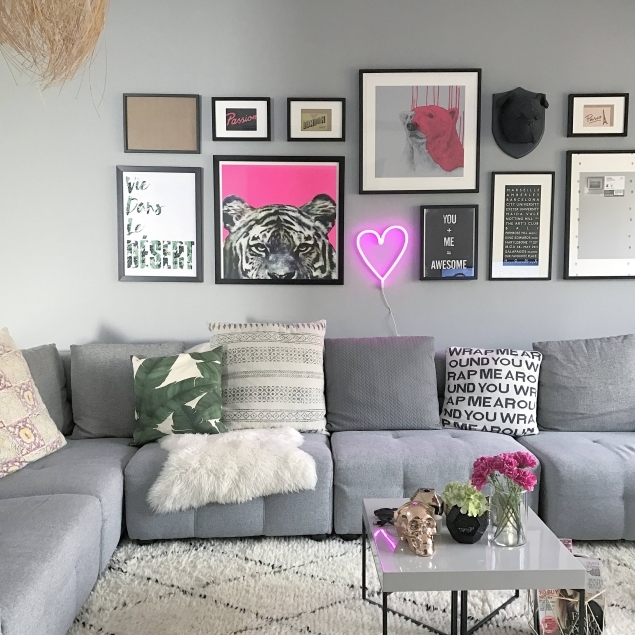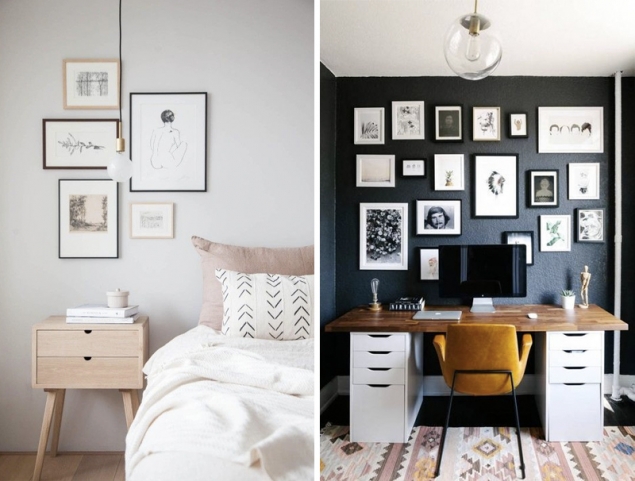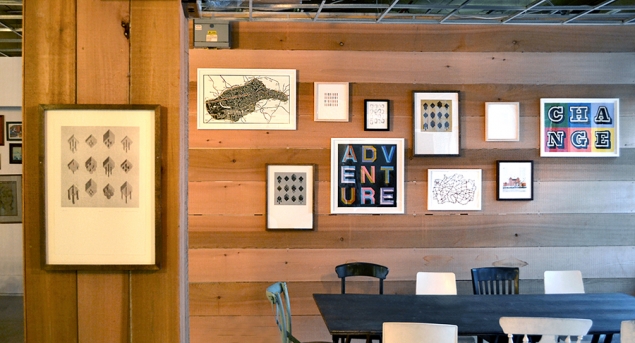Originating in 17th century France, the Salon-style hang quickly became a way of bringing art to the masses and breaking down the cultural walls of the elite classes. It’s a trend that has transcended the worlds of art and interiors, especially popular today as a means of displaying even the most eclectic of collections. Gallery or Salon-style hangs offer an affordable way to transform a room and create a dramatic feature, while flaunting your favourite works in the process; you’ll be surprised at how much cohesion the juxtaposition of artworks in every medium can bring to a space.
Hanging art with total freedom may seem like a daunting task, even for the most experienced hangers and collectors amongst us, but just remember that the gallery wall is all about expressing your personal taste, so be fearless and follow our simple steps, and you’ll be well on your way to achieving the look in your home.

Photograph courtesy of Stella + the Stars
1 Choose Your Space
First things first, pick your location. Whether you wish to stagger your staircase with wonderful works, create a statement in the living room, add inspiration to your home study, or draw attention to an overlooked corner, a salon wall will make a feature out of any space.
Left: A Salon-style hang of alphabet linocut prints capturing London landmarks by Tobias Till
Once you’ve selected your room of choice, consider the atmosphere you’re looking to create with your art. The bedroom is a space to unwind, so try to consider quality over quantity and allow plenty of space between your works to let them breathe. If you’re adorning your kitchen with a salon wall, be wary not to place works in any ‘splash zones’ or near sources of heat or humidity, and mix up your mediums - a decorative or sculptural approach won’t go amiss here. If you’re enlivening your living room, why not keep it close to home by mixing your artworks with family photos, film posters, artist postcards, children’s drawings or illustrations.

2 Show Your Personality
A gallery wall should offer a window onto your personality and your taste in art. Layer your works to emphasise a theme and be bold with your framing. If you’re hanging a series of works from one artist, be uniform with your approach and use identical frames for each, perhaps even hanging in a grid-style. Or, if you’re displaying a diverse array of works - from original paintings all the way to postcards - try sourcing reclaimed, vintage or second hand frames to emphasise the eclectic nature of your installation.

Image courtesy of Flat15
3 Lay it Out
So you’ve chosen your space, and your artworks, and the next logical step is to measure your space. A risk free way to plan and envision your final hang is to lay all of your framed works on the floor and play with the arrangement to scale. If you want to be really sure, you can even cut out newspaper to the size of each piece, tack it to the wall and take a step back to double check.

Top tip: Always make sure to get a second opinion! Find your spouse or your housemates and get their input, you’ll be surprised at how helpful another pair of eyes can be.
4 Start Big
Don’t know where to begin? Create a focal point by starting with the largest item first. This will ensure a viewer’s eye travels in a circular motion, spanning the entire space. Spreading striking or highlight colours throughout your hang will also help to lengthen or heighten your feature and ensure the space looks edited, tying the works together. Balance and symmetry (or even asymmetry!) are key elements to consider, so let this guide your arrangement by maintaining equal spacing between pieces, and working from the centre outwards.

Works by: Slavomir Zombek, Ben Eine, Susan Stockwell, Clare Halifax, Stephen Walter and Mat Cahill
5 Hang With Precision
You’ve laid out your works and you’re ready to add energy and pizzazz to that blank wall. Your personality should shine through, and each space is different, so feel free to adapt our advice to suit, but here are some helpful tips and general rules to consider:
- Space your artworks at least 3 centimetres (1¼ inches) apart to ensure each piece stands out alone
- Follow the gallery golden-rule and hang your focal artwork with the centre of the piece at 150 centimetres (59 inches) from the floor to catch eye level
- Use a spirit level and mark the wall with pencil before you drill any holes
- Consider using D-rings rather than wire or string when hanging art, to avoid a crooked hang - simply remove the wire and insert screws in the wall to fit inside each D-ring
- Double, triple check your measurements
- Get hanging!

Left: Three Routemasters, £595

